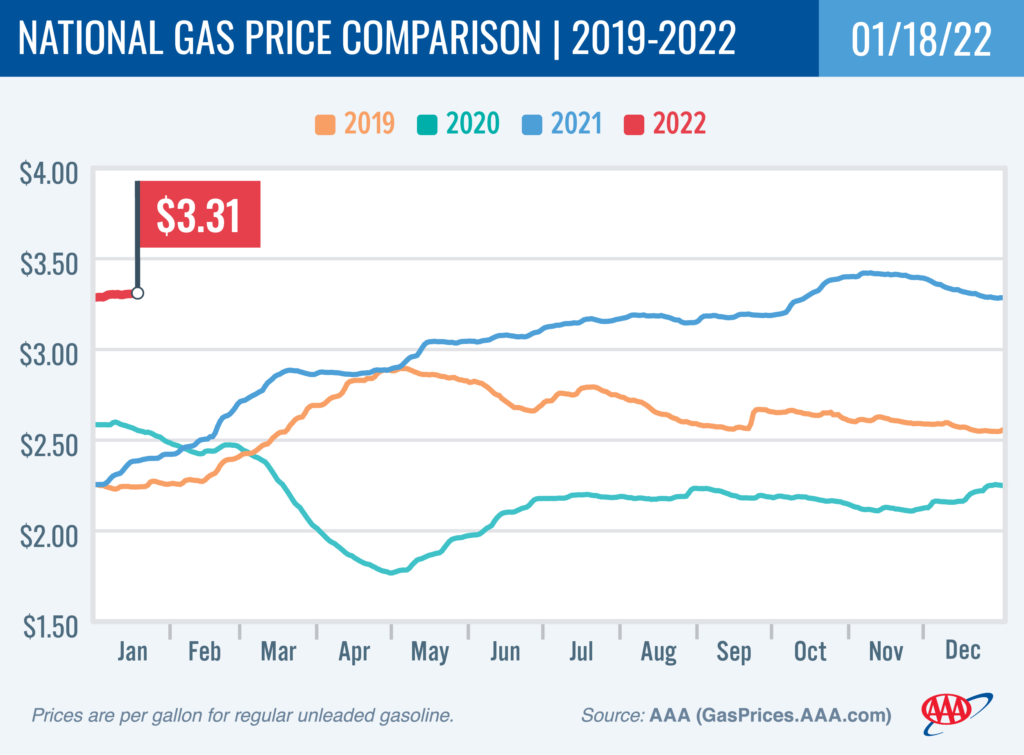WASHINGTON, D.C. — Gasoline prices rose a penny last week, driven primarily by the cost of crude oil, which has vaulted above $80 a barrel. The primary reason for the rise in oil prices is the perception that the COVID-19 omicron variant may ebb, allowing the world’s economic engines to kick into high gear. The potential increase in oil demand, coupled with lagging crude production, will only increase prices. Since the price of oil accounts for roughly half of what consumers pay at the pump, higher oil costs will likely result in higher gasoline costs. The national average for a gallon of gas rose one cent to $3.31.
“In the past few weeks, we have seen the price for a barrel of oil slowly work its way from the mid-$60s to the low $80s,” said Andrew Gross, AAA spokesperson. “And the primary reason is global economic optimism, whether well-founded or not, that the worst of COVID may soon be behind us.”
According to new data from the Energy Information Administration (EIA), total domestic gasoline stocks rose by 7.9 million bbl to 240.7 million bbl last week. On the other hand, gasoline demand decreased from 8.17 million b/d to 7.91 million b/d. Winter weather and the COVID-19 omicron variant are the likely culprits behind this recent demand dip. Typically, pump prices decline due to lower gas demand and a rise in total stocks, but continued growth in the price of crude oil has helped to elevate pump prices. As oil prices continue to climb above $80 a barrel, pump prices will likely follow suit.
Today’s national average of $3.31 is a penny more than a month ago and 93 cents more than a year ago.

Quick Stats
- The nation’s top 10 largest weekly increases: Iowa (+6 cents), Minnesota (+6 cents), North Carolina (+5 cents), Missouri (+4 cents), North Dakota (+4 cents), Texas (+4 cents), Washington, D.C. (+4 cents), Wisconsin (+4 cents), Oklahoma (+3 cents) and Kansas (+3 cents).
- The nation’s top 10 most expensive markets: California ($4.65), Hawaii ($4.32), Washington ($3.95), Oregon ($3.91), Nevada ($3.81), Alaska ($3.76), Arizona ($3.58), Idaho ($3.54), Washington, D.C. ($3.51) and Pennsylvania ($3.51).
Oil Market Dynamics
At the close of Friday’s formal trading session, WTI increased by $1.70 to settle at $83.82. Crude prices rose last week after the EIA reported that total domestic crude stocks decreased by 4.6 million bbl to 413.3 million bbl. The current stock level is approximately 14.3 percent lower than during the first week of January 2021, contributing to pressure on domestic crude prices. For this week, crude prices could continue to climb if EIA’s next report shows another decrease in total inventory.
Motorists can find current gas prices along their route with the free AAA Mobile app for iPhone, iPad, and Android. The app can also map a route, find discounts, book a hotel, and access AAA roadside assistance. Learn more at AAA.com/mobile.
